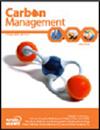量化墨西哥农业、林业和其他土地利用在经济上可行的缓解潜力
IF 3.2
4区 环境科学与生态学
Q3 ENVIRONMENTAL SCIENCES
引用次数: 1
摘要
各国往往缺乏快速而有力地全面确定土地利用领域温室气体(GHG)减排行动及其影响的方法,以支持对《巴黎协定》的承诺。我们提出了基于易于获得的空间数据和与作物、牲畜和林业有关的缓解采用成本的快速评估方法,以确定优先地点和行动。将方法应用于墨西哥的案例,我们发现全国减排潜力为8788万吨(Mt)二氧化碳当量年- 1,其中作物、畜牧业和林业/农林复合林业分别为7.91、7.66和7231万吨二氧化碳当量年- 1。在州一级,恰帕斯州的缓解潜力最高(13 Mt CO2eq),其次是坎佩切州(8 Mt CO2eq)。11个州的土地利用缓解潜力在250万吨至650万吨二氧化碳当量之间,而其他州的缓解潜力不到200万吨二氧化碳当量。作物和牲畜的缓解方案可分别减少60%和6%的排放量。林业的缓解方案可以减少一半的排放量。如果实施得当,与涉及净成本的畜牧业和林业方案相比,可以实现对农田的缓解潜力,并带来净效益。该方法支持按地点和分部门以科学为基础确定缓解行动的优先事项,并应有助于为各国未来的政策和国家自主贡献的实施提供信息。本文章由计算机程序翻译,如有差异,请以英文原文为准。
Quantification of economically feasible mitigation potential from agriculture, forestry and other land uses in Mexico
Abstract Countries often lack methods for rapidly, but robustly determining greenhouse gas (GHG) mitigation actions and their impacts comprehensively in the land use sector to support commitments to the Paris Agreement. We present rapid assessment methods based on easily available spatial data and adoption costs for mitigation related to crops, livestock and forestry to identify priority locations and actions. Applying the methods for the case of Mexico, we found a national mitigation potential of 87.88 million tons (Mt) CO2eq yr−1, comprising 7.91, 7.66 and 72.31 Mt CO2eq yr−1 from crops, livestock and forestry/agro-forestry, respectively. At the state level, mitigation potentials were highest in Chiapas (13 Mt CO2eq) followed by Campeche (8 Mt CO2eq). Eleven states had a land use mitigation potential between 2.5 to 6.5 Mt CO2eq, while other states had mitigation potentials of less than 2 Mt CO2eq. Mitigation options for crops and livestock could reduce 60% and 6% of the respective emissions. Mitigation options for forestry could reduce emissions by half. If properly implemented, mitigation potentials on cropland can be realized with net benefits, compared to livestock and forestry options, which involve net costs. The method supports science-based priority setting of mitigation actions by location and subsector and should help inform future policy and implementation of countries’ nationally determined contributions.
求助全文
通过发布文献求助,成功后即可免费获取论文全文。
去求助
来源期刊

Carbon Management
ENVIRONMENTAL SCIENCES-
CiteScore
5.80
自引率
3.20%
发文量
35
期刊介绍:
Carbon Management is a scholarly peer-reviewed forum for insights from the diverse array of disciplines that enhance our understanding of carbon dioxide and other GHG interactions – from biology, ecology, chemistry and engineering to law, policy, economics and sociology.
The core aim of Carbon Management is it to examine the options and mechanisms for mitigating the causes and impacts of climate change, which includes mechanisms for reducing emissions and enhancing the removal of GHGs from the atmosphere, as well as metrics used to measure performance of options and mechanisms resulting from international treaties, domestic policies, local regulations, environmental markets, technologies, industrial efforts and consumer choices.
One key aim of the journal is to catalyse intellectual debate in an inclusive and scientific manner on the practical work of policy implementation related to the long-term effort of managing our global GHG emissions and impacts. Decisions made in the near future will have profound impacts on the global climate and biosphere. Carbon Management delivers research findings in an accessible format to inform decisions in the fields of research, education, management and environmental policy.
 求助内容:
求助内容: 应助结果提醒方式:
应助结果提醒方式:


